.
18.06.2015
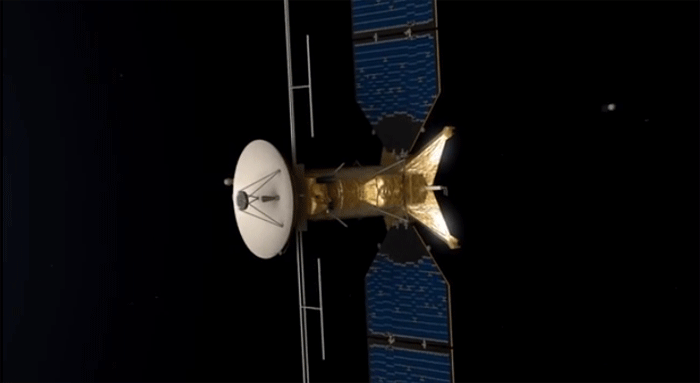
Beyond Earth, Jupiter’s moon Europa is considered one of the most promising places in the solar system to search for signs of present-day life, and a new NASA mission to explore this potential is moving forward from concept review to development.
NASA’s mission concept -- to conduct a detailed survey of Europa and investigate its habitability -- has successfully completed its first major review by the agency and now is entering the development phase known as formulation.
“Today we’re taking an exciting step from concept to mission, in our quest to find signs of life beyond Earth,” said John Grunsfeld, associate administrator for NASA’s Science Mission Directorate in Washington. “Observations of Europa have provided us with tantalizing clues over the last two decades, and the time has come to seek answers to one of humanity’s most profound questions.”
NASA’s Galileo mission to Jupiter in the late 1990s produced strong evidence that Europa, about the size of Earth’s moon, has an ocean beneath its frozen crust. If proven to exist, this global ocean could hold more than twice as much water as Earth. With abundant salt water, a rocky sea floor, and the energy and chemistry provided by tidal heating, Europa may have the ingredients needed to support simple organisms.
The mission plan calls for a spacecraft to be launched to Jupiter in the 2020s, arriving in the distant planet’s orbit after a journey of several years. The spacecraft would orbit the giant planet about every two weeks, providing many opportunities for close flybys of Europa. The mission plan includes 45 flybys, during which the spacecraft would image the moon's icy surface at high resolution and investigate its composition and the structure of its interior and icy shell.
NASA's Jet Propulsion Laboratory (JPL) in Pasadena, California, has been assigned the responsibility of managing the project. JPL has been studying the multiple-flyby mission concept, in collaboration with the Johns Hopkins University Applied Physics Laboratory (APL) in Laurel, Maryland, since 2011.
Instruments selected for the Europa mission's scientific payload were announced by NASA on May 26. Institutions supplying instruments include APL; JPL; Arizona State University, Tempe; the University of Texas at Austin; Southwest Research Institute, San Antonio and the University of Colorado, Boulder.
“It’s a great day for science,” said Joan Salute, Europa program executive at NASA Headquarters in Washington. “We are thrilled to pass the first major milestone in the lifecycle of a mission that will ultimately inform us on the habitability of Europa.”
NASA's Science Mission Directorate in Washington conducts a wide variety of research and scientific exploration programs for Earth studies, space weather, the solar system and the universe.
.
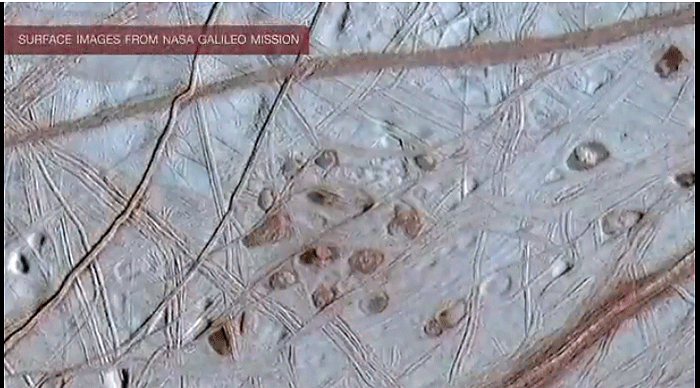
Jupiter-Mond Europa
---
Europa's Jupiter-Facing Hemisphere
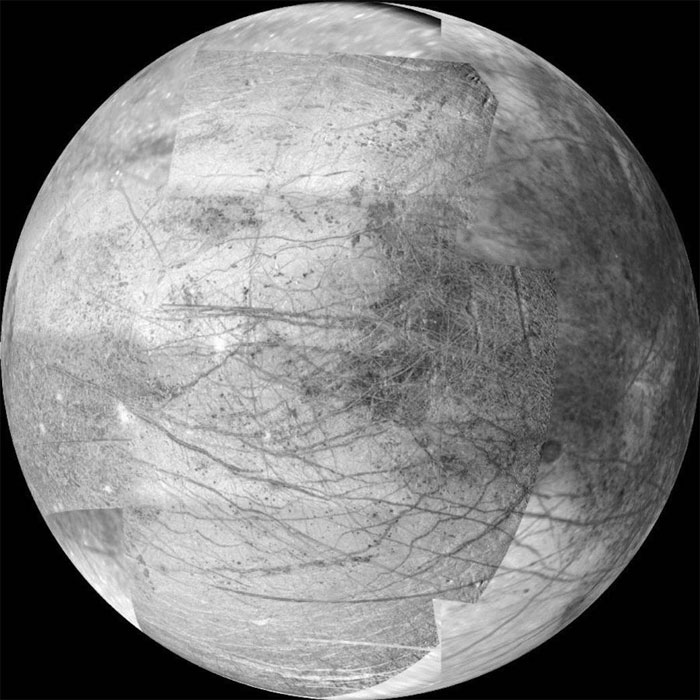
This 12-frame mosaic provides the highest resolution view ever obtained of the side of Jupiter's moon Europa that faces the giant planet. It was obtained on Nov. 25, 1999 by the camera onboard the Galileo spacecraft, a past NASA mission to Jupiter and its moons which ended in 2003. NASA will announce today, Tuesday, May 26, the selection of science instruments for a mission to Europa, to investigate whether it could harbor conditions suitable for life. The Europa mission would conduct repeated close flybys of the small moon during a three-year period.
Numerous linear features in the center of this mosaic and toward the poles may have formed in response to tides strong enough to fracture Europa's icy surface. Some of these features extend for over 1,500 kilometers (900 miles). Darker regions near the equator on the eastern (right) and western (left) limb may be vast areas of chaotic terrain. Bright white spots near the western limb are the ejecta blankets of young impact craters.
North is to the top of the picture and the sun illuminates the surface from the left. The image, centered at 0 latitude and 10 longitude, covers an area approximately 2,500 by 3,000 kilometers. The finest details that can discerned in this picture are about 2 kilometers across (about 1,550 by 1,860 miles). The images were taken by Galileo's camera when the spacecraft was 94,000 kilometers (58,000 miles) from Europa.
Image Credit: NASA/JPL/University of Arizona
---
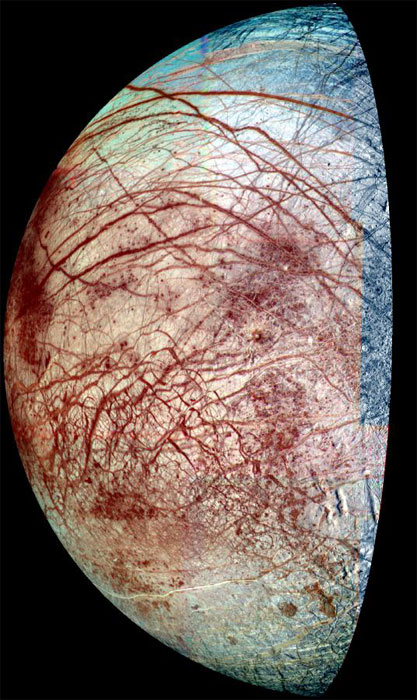
PIAO2590 Europa Moon
-
The puzzling, fascinating surface of Jupiter’s icy moon Europa looms large in this newly-reprocessed color view, made from images taken by NASA's Galileo spacecraft in the late 1990s. This is the color view of Europa from Galileo that shows the largest portion of the moon's surface at the highest resolution.
The view was previously released as a mosaic with lower resolution and strongly enhanced color (see PIA02590). To create this new version, the images were assembled into a realistic color view of the surface that approximates how Europa would appear to the human eye.
The scene shows the stunning diversity of Europa’s surface geology. Long, linear cracks and ridges crisscross the surface, interrupted by regions of disrupted terrain where the surface ice crust has been broken up and re-frozen into new patterns.
Color variations across the surface are associated with differences in geologic feature type and location. For example, areas that appear blue or white contain relatively pure water ice, while reddish and brownish areas include non-ice components in higher concentrations. The polar regions, visible at the left and right of this view, are noticeably bluer than the more equatorial latitudes, which look more white. This color variation is thought to be due to differences in ice grain size in the two locations.
Images taken through near-infrared, green and violet filters have been combined to produce this view. The images have been corrected for light scattered outside of the image, to provide a color correction that is calibrated by wavelength. Gaps in the images have been filled with simulated color based on the color of nearby surface areas with similar terrain types.
This global color view consists of images acquired by the Galileo Solid-State Imaging (SSI) experiment on the spacecraft's first and fourteenth orbits through the Jupiter system, in 1995 and 1998, respectively. Image scale is 1 mile (1.6 kilometers) per pixel. North on Europa is at right.
The Galileo mission was managed by NASA's Jet Propulsion Laboratory in Pasadena, California, for the agency's Science Mission Directorate in Washington. JPL is a division of the California Institute of Technology, Pasadena
Quelle:NASA
-
Update: 11.08.2015
.
NASA's Europa Mission Team Joins Forces for the First Time
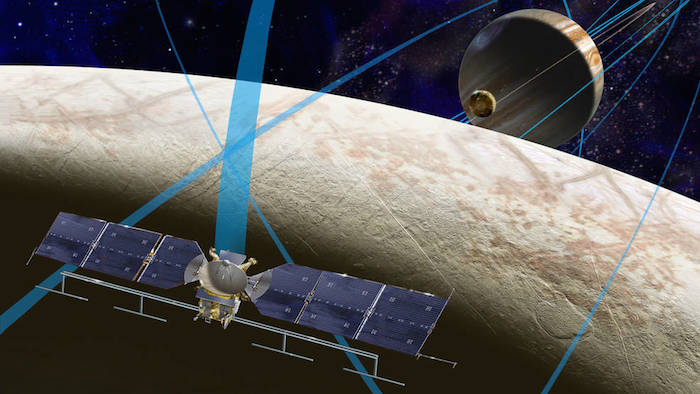
Artist's rendering of NASA's Europa mission spacecraft.
Credits: NASA/JPL-Caltech
.
They're united by a lofty goal -- to investigate whether Jupiter's moon Europa could harbor primitive life under its icy shell. Last week, a team of scientists and engineers for NASA's planned mission to Europa met for the first time at NASA's Jet Propulsion Laboratory in Pasadena, California, to begin turning that goal into reality.
After years of planning and hoping, the premier gathering was the final page of the team's origin story and the beginning of a new chapter that could last as long as two decades.
"We have a rare and wonderful opportunity with this mission to investigate whether Europa could be an abode for life," said Curt Niebur, Europa mission program scientist at NASA Headquarters in Washington, at the meeting's opening. "We're in the service of our colleagues, our scientific community, our country and our fellow human beings. It's a responsibility we take very seriously."
The mission plan calls for a spacecraft to be launched to Jupiter in the 2020s, arriving in the distant planet's orbit after a journey of several years. The spacecraft would orbit the gas giant planet about every two weeks, providing many opportunities for close flybys of Europa. The mission plan includes 45 flybys, during which the spacecraft would image the moon's icy surface at high resolution and investigate its composition and the structure of its interior and icy shell. In late May, NASA announced the selection of instruments for the mission's scientific payload, while in June the mission formally entered the development phase known as formulation.
Thought to contain an ocean of liquid water beneath its icy surface, Europa is considered one of the most promising places in the solar system beyond Earth to search for signs of present-day life, in the form of simple organisms.
At the introductory meeting, players in the room included many stars in the field of planetary exploration. Some came fresh from leading roles in the recent successful flyby of Pluto by NASA's New Horizons mission. Several have worked together for decades, exploring Europa and other icy moons with NASA's Cassini, Galileo and Voyager missions.
In addition to its veteran explorers, the Europa mission also includes younger team members who've begun making their contributions to the field more recently. Together, the assembled team of scientists and spacecraft engineers made for a group filled with possibilities for collaboration.
"That's why we're here, in one room, at the very start of the project," said Robert Pappalardo, Europa project scientist at JPL. "So we can begin to function as one team, to understand the cross-cutting science issues we all face, and so we can use all of our tools together to understand Europa."
Mission engineers had already been hard at work for the past couple of years, developing the overall concept that eventually became NASA's mission to Europa. They are charged with designing the spacecraft and choreographing its flight plan, and -- of course -- building the complex robotic space probe. Their initial briefing to the scientists included information on how to design the mission for Jupiter's hazardous radiation environment, and plans for integrating the recently selected science instruments into the probe's overall architecture.
"The engineering team has already made great progress, and we're in excellent shape for this phase of the mission," Barry Goldstein, Europa project manager at JPL, reported to the team. "I couldn't be more excited about the work we've done and the road ahead."
The top priority for the mission's first meeting was to begin the work of refining the mission's science, especially with regard to how the instruments can best work together to achieve NASA's main objective for Europa. "Your instruments were each selected separately," said Pappalardo, "But now we want to understand how they can best work together to achieve the overarching goal, which is to investigate the habitability of this icy ocean moon."
NASA's Jet Propulsion Laboratory manages the Europa mission for NASA's Science Mission Directorate in Washington. The multiple-flyby Europa mission concept was developed in partnership with the Johns Hopkins University Applied Physics Laboratory, Laurel, Maryland.
.
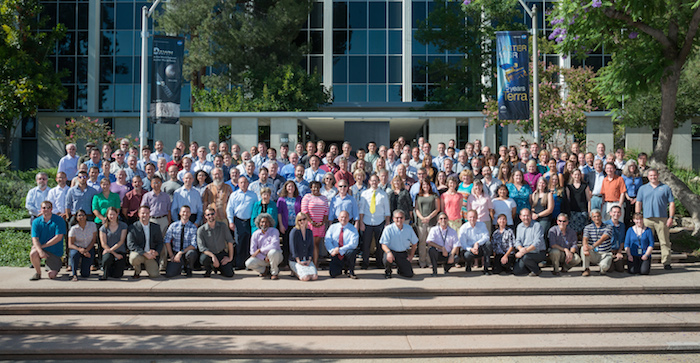
The team behind NASA's mission to Europa at their first face-to-face meeting at JPL in August 2015.
Credits: NASA/JPL-Caltech
Quelle: NASA
5394 Views
